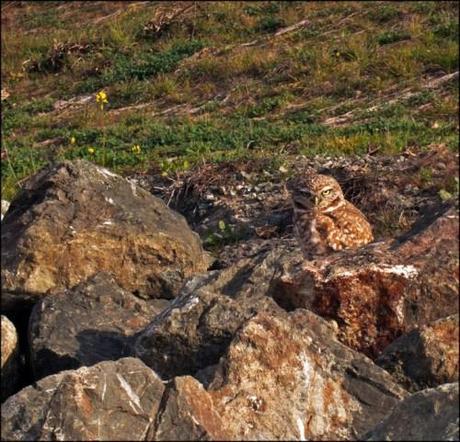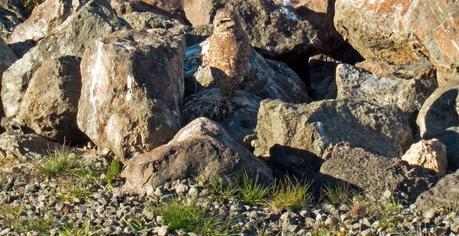Athene cunicularia
 A Western burrowing owl at the Berkeley Marina. Photos by Neil Mishalov. (Source)
A Western burrowing owl at the Berkeley Marina. Photos by Neil Mishalov. (Source)

The Burrowing Owl (Athene cunicularia) is a tiny but long-legged owl found throughout open landscapes – grasslands, rangelands, agricultural areas, deserts — of North and South America. They nest and roost in burrows, such as those excavated by prairie dogs. Unlike most owls, Burrowing Owls are often active during the day, although they tend to avoid the midday heat. But like many other kinds of owls, Burrowing Owls do most of their hunting from dusk until dawn, when they can use their night vision and hearing to their advantage.
Burrowing Owls have bright yellow eyes; their beaks can be dark yellow or gray depending on the subspecies. They have prominent white eyebrows and a white “chin” patch which they expand and display during certain behaviors, such as a bobbing of the head when agitated.
Males and females are similar in size and appearance, and display little sexual dimorphism. Adult males appear lighter in color than females because they spend more time outside the burrow during daylight, and their feathers become “sun-bleached”. The burrowing owl measures 7.5–11 in long, spans 20–24 in across the wings and weighs 4.9–8.5 oz. As a size comparison, an average adult is slightly larger than an American Robin.
This species can live for at least 9 years in the wild and over 10 years in captivity. When hunting, they wait on a perch until they spot prey. Then, they swoop down on prey or fly up to catch insects in flight. Sometimes, they chase prey on foot across the ground. Burrowing Owls mainly eat large insects and small rodents. Unlike other owls, they also eat fruits and seeds.
The owls nest in an underground burrow, hence the name Burrowing Owl. If burrows are unavailable and the soil is not hard or rocky, the owls may excavate their own.
During the nesting season, Burrowing Owls will collect a wide variety of materials to line their nest, some of which are left around the entrance to the burrow. The most common material is mammal dung, usually from cattle. Researchers believe the dung helps to control the microclimate inside the burrow and to attract insects, which the owls may eat.

After the eggs hatch, both parents will feed the chicks. Four weeks after hatching, the chicks can make short flights and begin leaving the nest burrow. The parents will still help feed the chicks for 1 to 3 months. While most of the eggs will hatch, only 4–5 chicks usually survive to leave the nest.
The Burrowing Owl is endangered in Canada, threatened in Mexico, and a species of special concern in Florida and most of the western USA. It is a state threatened species in Colorado, and a “species of special concern” in California as their population has been declining. Burrowing Owls are protected under the Migratory Bird Treaty Act in Canada, the United States, and Mexico.
~Eowyn

